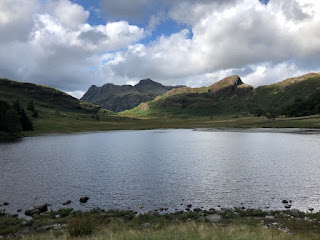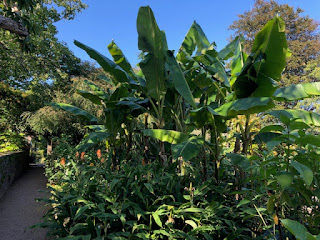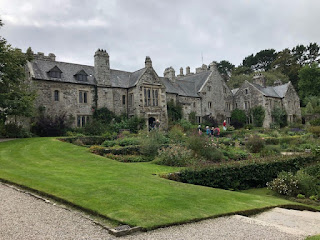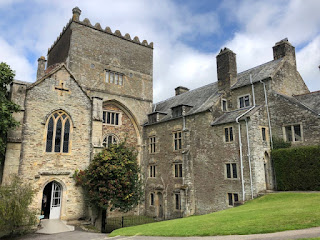I suggested recently that if anyone wanted to start their own National Trust blog you could do worse than to choose National Trust Beaches. Well, here's an even better idea for you: National Trust Pubs. It turns out that there are around 40 of them, Sticklebarn in the Lake District being one. What a pub crawl that would be.
Anyway. Sticklebarn and The Langdales might sound like the band at Worzel Gummidge's wedding but it's actually a pub and a very scenic area:
You really do need a special dictionary in the Lake District - I only just discovered that a stickle is "a hill with a prominent rocky top." What with ghylls, fells, tarns, forces, thwaites, and meres, you really do need to pay attention to what you're agreeing to.
Anyway. If you like walking, cycling, and camping then you'll love this beautiful area of the country. There's a real buzz - people setting off on walks, or returning from walks, or walking into the pub having completed a walk.
The Sticklebarn scone
But let's move on to the scone. This was the third (yes, third) scone of the day (after Fell Foot and Wray Castle) and it was still only 2pm. We decided to go crazy and have some lunch as well, so what with sausage rolls and baked potatoes thrown in to the mix it was all turning into a highly unusual scone mission.
The scone itself was a lot smaller than the Fell Foot and Wray Castle ones, which wasn't necessarily a bad thing - if most people drop in to Sticklebarn for hearty meals to get them up the fells, then a scone-as-dessert might be appropriate. And it was definitely fresher than the one we'd just had at Wray. It just wasn't quite up to the standards of the legendary scone we'd had at Fell Foot.
Sticklebarn was my second National Trust pub, as I had been to The George Inn in Southwark in my previous life as a London pub expert*. If you'd like to see the list of all NT hostelries, you can find it here.
*I wasn't a certified or qualified London pub expert. I just went to a lot of London pubs.
Sticklebarn: 5 out of 5
Scone: 4 out of 5
Ticking second National Trust pub off the list: 5 out of 5
Other National Trust properties we've visited in the Lake District: Acorn Bank, Allan Bank, Fell Foot, Hill Top, Sizergh Castle, Wordsworth House, Wray Castle
Anyway. Sticklebarn and The Langdales might sound like the band at Worzel Gummidge's wedding but it's actually a pub and a very scenic area:
- Great Landgale is a U-shaped valley containing the Langdale Pikes (a group of mountains) and two villages. It was the centre of the Lake District's slate industry and there are still slate works there today.
- Little Langdale is a valley containing a hamlet, as well as two tarns (mountain lakes created by glaciers); Little Langdale Tarn and Blea Tarn
- Sticklebarn is a pub (a place serving alcohol), providing food and drinks to weary walkers
 |
| I'm not sure why I took a picture featuring a drain-pipe, rather than the cosy interior of the pub. You'll just have to imagine that part. |
Anyway. If you like walking, cycling, and camping then you'll love this beautiful area of the country. There's a real buzz - people setting off on walks, or returning from walks, or walking into the pub having completed a walk.
 |
| Blea Tarn - surely one of the world's most beautiful spots |
But let's move on to the scone. This was the third (yes, third) scone of the day (after Fell Foot and Wray Castle) and it was still only 2pm. We decided to go crazy and have some lunch as well, so what with sausage rolls and baked potatoes thrown in to the mix it was all turning into a highly unusual scone mission.
The scone itself was a lot smaller than the Fell Foot and Wray Castle ones, which wasn't necessarily a bad thing - if most people drop in to Sticklebarn for hearty meals to get them up the fells, then a scone-as-dessert might be appropriate. And it was definitely fresher than the one we'd just had at Wray. It just wasn't quite up to the standards of the legendary scone we'd had at Fell Foot.
Sticklebarn was my second National Trust pub, as I had been to The George Inn in Southwark in my previous life as a London pub expert*. If you'd like to see the list of all NT hostelries, you can find it here.
*I wasn't a certified or qualified London pub expert. I just went to a lot of London pubs.
Sticklebarn: 5 out of 5
Scone: 4 out of 5
Ticking second National Trust pub off the list: 5 out of 5
Other National Trust properties we've visited in the Lake District: Acorn Bank, Allan Bank, Fell Foot, Hill Top, Sizergh Castle, Wordsworth House, Wray Castle





































